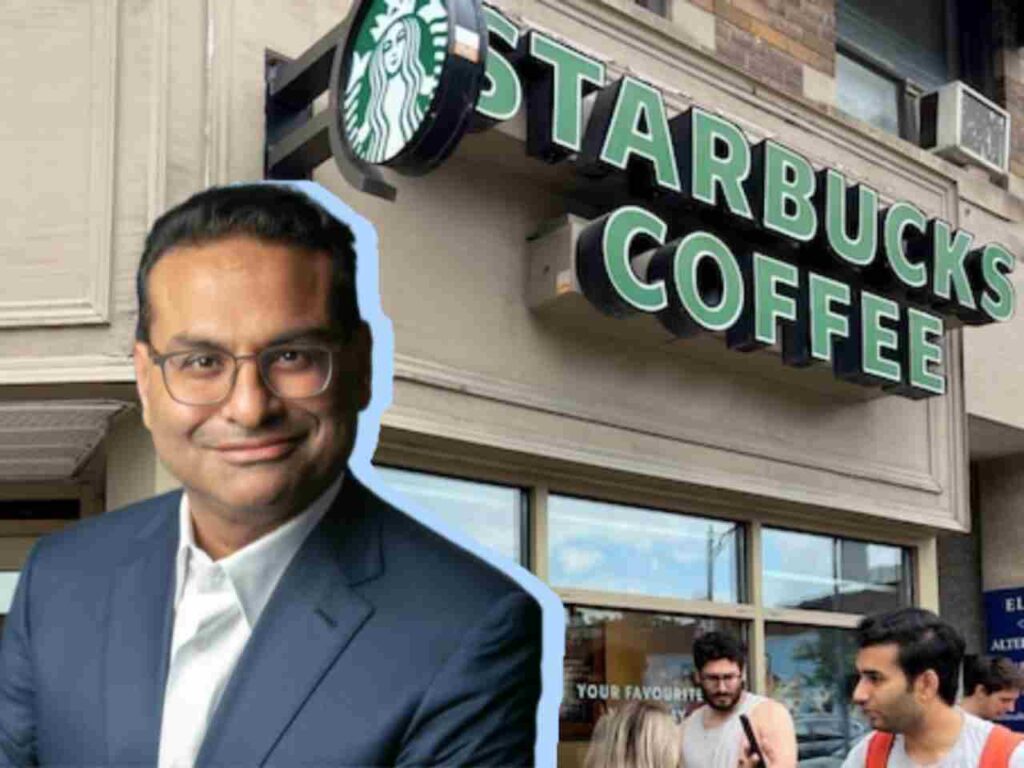Laxman Narasimhan’s Background and Journey to Starbucks CEO

Laxman Narasimhan, the current CEO of Starbucks, boasts a remarkable career trajectory marked by leadership roles in diverse industries, particularly consumer-facing ones. His journey to the helm of this iconic coffee giant is a testament to his strategic acumen, operational expertise, and a deep understanding of consumer behavior.
Narasimhan’s Career Path and Key Accomplishments
Narasimhan’s professional journey began at PepsiCo, where he spent over a decade honing his skills in marketing, sales, and general management. He ascended through the ranks, ultimately becoming the CEO of PepsiCo’s Latin American Beverages business. This experience provided him with invaluable insights into the global beverage market and the complexities of navigating diverse cultural landscapes.
Following his tenure at PepsiCo, Narasimhan joined Reckitt Benckiser, a global consumer goods company, as the CEO of its global health division. Here, he led the transformation of a sprawling portfolio of brands, focusing on innovation, digitalization, and building a robust e-commerce presence. This role showcased his ability to lead large-scale organizations through periods of significant change and growth.
Prior to joining Starbucks, Narasimhan served as the CEO of the global consulting firm, E*TRADE Financial Corporation, where he spearheaded a comprehensive digital transformation initiative. This experience equipped him with the necessary skills to navigate the evolving digital landscape and leverage technology to enhance customer experiences.
Narasimhan’s Leadership Style and Management Philosophies
Narasimhan’s leadership style is characterized by a collaborative approach, a focus on data-driven decision-making, and a commitment to empowering employees. He believes in fostering a culture of innovation and encouraging employees to take calculated risks. He also emphasizes the importance of building strong relationships with customers, suppliers, and partners.
One of Narasimhan’s key management philosophies is the importance of “customer-centricity.” He believes that every decision should be made with the customer in mind, and that companies must continuously strive to exceed customer expectations. This philosophy aligns perfectly with Starbucks’ focus on delivering an exceptional customer experience.
Experience in Consumer-Facing Industries, Starbucks ceo laxman narasimhan
Narasimhan’s extensive experience in consumer-facing industries has provided him with a deep understanding of consumer behavior, market trends, and the importance of building strong brands. He has a proven track record of successfully navigating complex market dynamics and developing innovative strategies to meet evolving consumer needs.
His time at PepsiCo, Reckitt Benckiser, and E*TRADE Financial Corporation has exposed him to diverse consumer segments across the globe, enabling him to develop a nuanced understanding of different cultural preferences and consumption patterns. This knowledge will be invaluable as he leads Starbucks through its next chapter of growth and expansion.
Starbucks’ Current Landscape and Challenges

Starbucks, a global coffee giant, faces a complex and dynamic landscape, with several challenges impacting its operations and future growth. The company’s success relies on navigating a competitive market, adapting to evolving consumer preferences, and maintaining operational efficiency. Recent economic trends have further amplified these challenges, requiring Starbucks to strategically adapt its approach to remain competitive.
Competition in the Coffee Industry
The coffee industry is highly competitive, with a multitude of players vying for market share. Starbucks faces competition from various sources, including:
- Specialty Coffee Shops: Independent coffee shops and smaller chains like Blue Bottle Coffee and Stumptown Coffee Roasters are gaining popularity, offering a more artisanal and personalized experience. These competitors often focus on sourcing high-quality beans, unique brewing methods, and a strong community focus.
- Fast-Food Chains: Fast-food chains like McDonald’s and Dunkin’ Donuts are increasingly offering high-quality coffee options at competitive prices, attracting price-sensitive customers. This competition poses a significant threat to Starbucks’ core customer base.
- Convenience Stores: Convenience stores like 7-Eleven and Circle K are also entering the coffee market, offering quick and affordable options for consumers on the go. This increased convenience is a challenge for Starbucks, which relies on its premium pricing and in-store experience.
- Grocery Stores: Grocery stores are increasingly selling high-quality coffee beans and brewing equipment, allowing customers to enjoy their favorite coffee at home. This trend threatens Starbucks’ in-store sales and creates a new competitive landscape.
Evolving Consumer Preferences
Consumer preferences for coffee are constantly evolving, driven by factors such as health consciousness, ethical sourcing, and sustainability. Starbucks needs to adapt its offerings and strategies to meet these changing demands:
- Health and Wellness: Consumers are increasingly prioritizing health and wellness, seeking healthier options with lower sugar and calorie content. Starbucks has responded by introducing alternative milk options, plant-based food items, and sugar-free beverages. However, the company needs to continue innovating and expanding its healthy offerings to meet evolving consumer preferences.
- Ethical Sourcing and Sustainability: Consumers are increasingly demanding transparency and ethical sourcing practices from brands. Starbucks has made significant efforts to promote ethical sourcing and sustainability, but it needs to continuously improve its efforts to meet consumer expectations and stay ahead of competitors.
- Personalized Experiences: Consumers are seeking personalized experiences and tailored offerings. Starbucks has implemented mobile ordering and personalized recommendations, but it needs to further enhance its digital capabilities and create more personalized experiences to stay relevant.
Operational Efficiency and Cost Management
Maintaining operational efficiency and managing costs are crucial for Starbucks’ profitability, especially in the current economic climate. The company faces challenges related to:
- Rising Labor Costs: Labor costs are a significant expense for Starbucks, and rising wages and labor shortages are impacting its profitability. The company needs to find ways to optimize staffing levels and improve employee productivity to manage these costs.
- Supply Chain Disruptions: Global supply chain disruptions have impacted Starbucks’ ability to source raw materials and transport finished goods. The company needs to strengthen its supply chain resilience and find alternative sources to mitigate these disruptions.
- Inflationary Pressures: Inflationary pressures are increasing costs for raw materials, packaging, and transportation, putting pressure on Starbucks’ profit margins. The company needs to implement strategies to manage these costs and maintain price competitiveness.
Impact of Economic Trends
Recent economic trends, including inflation, rising interest rates, and a potential recession, are impacting the coffee industry and Starbucks’ business:
- Consumer Spending: Consumers are becoming more price-sensitive due to inflation and economic uncertainty. This could lead to a decrease in discretionary spending on coffee, impacting Starbucks’ sales.
- Supply Chain Costs: Rising energy prices and supply chain disruptions are increasing costs for Starbucks, impacting its profitability. The company needs to find ways to manage these costs and maintain its price competitiveness.
- Labor Market Dynamics: Economic uncertainty could lead to job losses and reduced consumer confidence, impacting Starbucks’ ability to attract and retain employees. The company needs to ensure it remains an attractive employer to navigate these challenges.
Starbucks’ Strategies and Initiatives
Starbucks has implemented several strategies and initiatives to address these challenges, including:
- Product Innovation: Starbucks is constantly introducing new products and beverages to meet evolving consumer preferences. This includes plant-based options, healthier choices, and innovative flavors. These initiatives aim to attract new customers and retain existing ones by providing diverse and appealing offerings.
- Digital Transformation: Starbucks is investing heavily in digital technologies to enhance customer experience and improve operational efficiency. This includes mobile ordering, personalized recommendations, and loyalty programs. These initiatives aim to streamline operations, improve customer engagement, and gather valuable data for decision-making.
- Sustainability Initiatives: Starbucks is committed to sustainability and ethical sourcing practices. The company has implemented programs to reduce its environmental footprint, promote ethical sourcing, and support local communities. These initiatives aim to enhance brand reputation, attract environmentally conscious consumers, and create a positive social impact.
- Cost Management Strategies: Starbucks is implementing cost management strategies to mitigate inflationary pressures and maintain profitability. This includes optimizing staffing levels, improving operational efficiency, and exploring alternative sourcing options. These initiatives aim to control costs, enhance efficiency, and protect profit margins.
Narasimhan’s Vision and Strategies for Starbucks: Starbucks Ceo Laxman Narasimhan

Laxman Narasimhan, the new CEO of Starbucks, has a clear vision for the company’s future, focusing on enhancing the customer experience, driving innovation, and expanding globally. His strategic priorities are built around three core pillars: customer connection, operational excellence, and growth.
Customer Connection
Narasimhan emphasizes the importance of building deeper connections with customers, recognizing their evolving needs and preferences. He plans to achieve this through personalized experiences, enhanced digital offerings, and a focus on inclusivity and community engagement.
- Personalized Experiences: Narasimhan envisions Starbucks becoming a more personalized brand, catering to individual customer preferences. This could involve leveraging data analytics to offer customized recommendations, tailored rewards programs, and personalized communication channels.
- Digital Transformation: Starbucks has already made significant strides in its digital transformation journey, but Narasimhan aims to accelerate this process. He plans to invest in technologies that enhance the customer experience, such as mobile ordering and payment, loyalty programs, and personalized app features. He also intends to integrate technology into the in-store experience, creating a seamless and efficient customer journey.
- Community Engagement: Starbucks has a long history of community involvement, and Narasimhan plans to further strengthen these connections. He believes that by supporting local communities and engaging with customers on a personal level, Starbucks can build stronger brand loyalty and create a sense of belonging.
Operational Excellence
Narasimhan recognizes the importance of operational excellence in delivering a consistent and high-quality customer experience. He plans to streamline operations, improve efficiency, and enhance the employee experience.
- Streamlined Operations: Narasimhan aims to optimize Starbucks’ operations by improving supply chain management, reducing waste, and implementing lean processes. This will ensure that customers receive their orders promptly and efficiently, while also minimizing costs and maximizing profitability.
- Employee Empowerment: Narasimhan believes that happy and engaged employees are crucial to delivering a positive customer experience. He plans to invest in employee training and development programs, creating a more supportive and inclusive work environment. By empowering employees, Narasimhan hopes to enhance their skills, motivation, and overall job satisfaction.
Growth and Expansion
Narasimhan sees significant growth opportunities for Starbucks, both domestically and internationally. He plans to expand the company’s footprint, introduce new products and services, and leverage technology to reach new markets.
- Global Expansion: Starbucks has a strong presence in many countries, but Narasimhan aims to expand into new markets, particularly in Asia and emerging economies. He plans to tailor the Starbucks experience to local tastes and preferences, while also leveraging the company’s global brand recognition and operational expertise.
- New Product Development: Narasimhan plans to invest in research and development to introduce innovative products and services. This could involve expanding Starbucks’ food and beverage offerings, introducing new formats like drive-thrus and kiosks, or exploring partnerships with other companies to create new experiences.
- Digital Innovation: Narasimhan recognizes the importance of digital innovation in reaching new customers and enhancing the customer experience. He plans to invest in technologies that enable Starbucks to offer personalized services, streamline operations, and expand its reach. This could include developing new mobile apps, introducing virtual reality experiences, or partnering with tech companies to create innovative solutions.
Starbucks CEO Laxman Narasimhan is a seasoned leader with a track record of success in global consumer goods. He joined the coffee giant in October 2022, bringing a wealth of experience from his time at PepsiCo, where he led global operations.
Narasimhan’s vision for Starbucks is ambitious, focusing on innovation, technology, and customer experience. To learn more about his plans for the future of the company, you can read about laxman narasimhan and his leadership style. With Narasimhan at the helm, Starbucks is poised for continued growth and success in the years to come.
Laxman Narasimhan, the new CEO of Starbucks, is tasked with navigating the coffee giant through a period of immense change. His background in consumer goods and experience with global brands like PepsiCo position him well to address evolving customer preferences and market dynamics.
To learn more about Narasimhan’s vision for Starbucks and the challenges he faces, check out this insightful article on starbucks ceo laxman narasimhan. Narasimhan’s leadership will be crucial in ensuring Starbucks maintains its iconic status and continues to innovate in the ever-evolving coffee industry.
